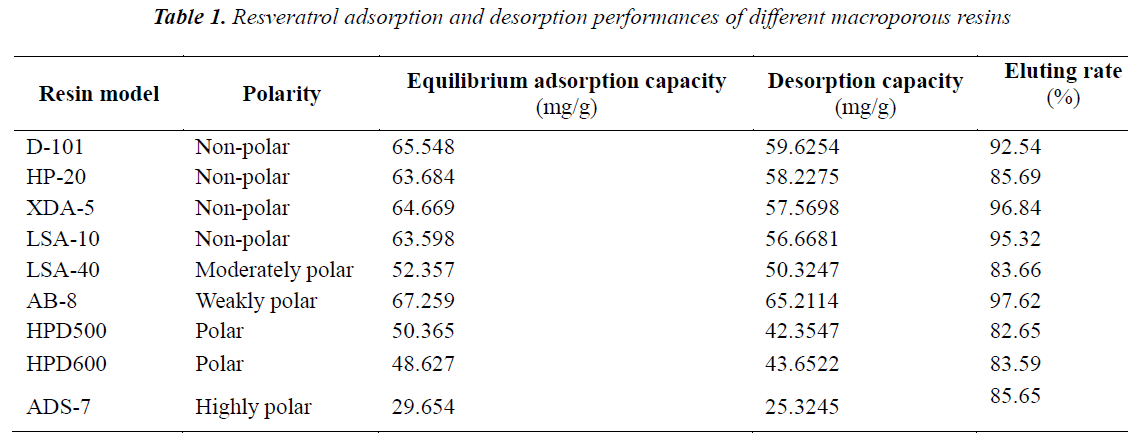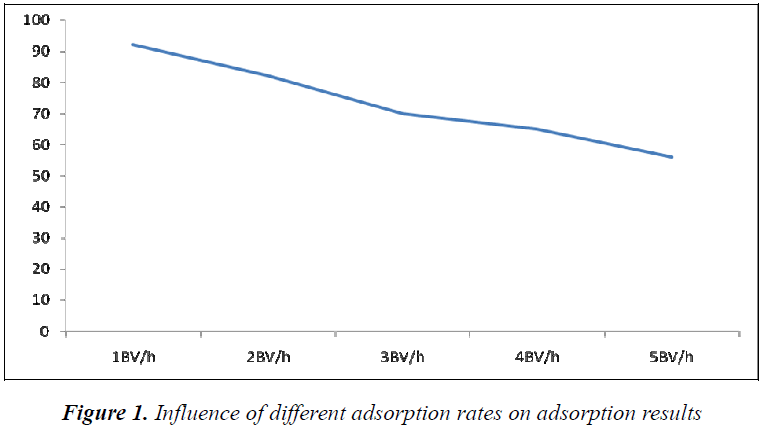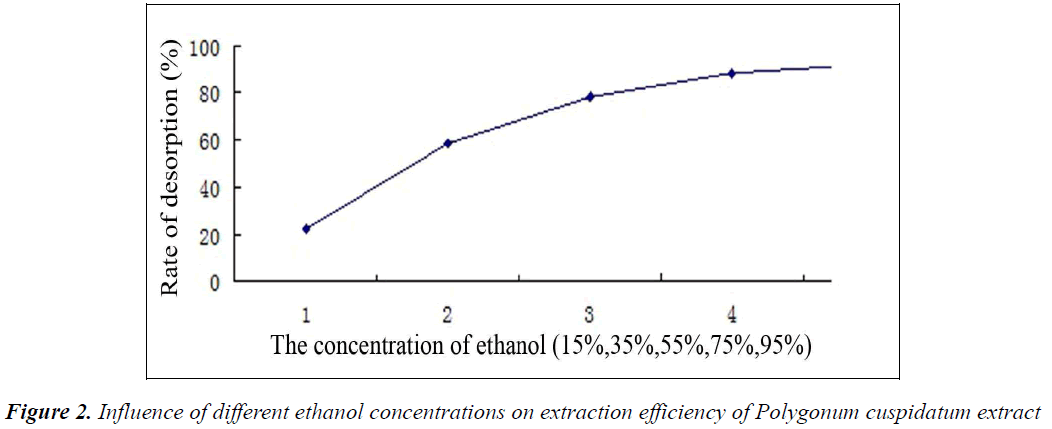- Biomedical Research (2015) Volume 26, Issue 3
Inhibitory effect of active extract of Polygonum Cuspidatum on human colon cancer SW480 Cells.
Jianlei Yuan*, Tao Lan, Jianzhong Liu, Guihua Wang, Qingsen Sun, Hui Chen, Junhua Ren, Jinsheng Zhang, Liansheng SunDepartment of Hepato-Biliary-Pancreatic, People Hospital of Cangzhou city, Cangzhou Hebei 061000, China
- Corresponding Author:
- Jianlei Yu
Department of Hepato-Biliary-Pancreatic People Hospital of Cangzhou City
7 Qingchi Road +Cangzhou Hebei 061000, China.
E-mail: yuanjianlei@yeah.net
Accepted Date: April 03 201
Abstract
This study was conducted to enrich and purify the active constituent in Polygonum cuspidatum, and to study its anticancer activity. Extraction conditions of Polygonum cuspidatum were optimized by investigating the macroporous resin model, flow rate and ethanol concentration. MTT assay and electron microscopy were used to analyze the inhibitory effect of Polygonum cuspidatum extract on human SW480 cells. During the investigation of enrichment and purification process, the optimal conditions for enrichment of Polygonum cuspidatum extract with D101 macroporous resin were identified to be a 3-fold amount of 75% ethanol, and a flow rate of 2 BV/h. Under electron microscope, nuclear morphological changes are seen in SW480 cells treated with Polygonum cuspidatum extract; apoptotic characteristics are significant, and apoptotic bodies are formed eventually. MTT assay results showed that the inhibitory effect of Polygonum cuspidatum extract on SW480 cells increases with the increase of concentration and prolongation of action time within the experimental concentration range, which proves a dose- and time-dependence of action. Polygonum cuspidatum extract has a marked inhibitory effect on human colon cancer SW480 cells.
Keywords
Polygonum cuspidatum; resveratrol; SW480 cell
Introduction
Traditional Chinese medicine Hu Zhang is the dried roots and rhizomes of Polygonum cuspidatum Sieb.et Zucc. It is bitter, slightly cold, and enters the liver, gallbladder and lung meridians. It possesses wind-expelling and diuresis- promoting, stasis-dissipating, pain-relieving, cough-suppressing and phlegm-resolving functions [1], and is mainly used for joint arthralgia, damp-heat jaundice, amenorrhea, abdominal mass, expectoration, water and fire burns, traumatic injury, carbuncle, sore, etc. At present, Polygonum cuspidatum is mainly found in China's eastern, central, southern and southwestern provinces and regions [2].
Polygonum cuspidatum mainly contains anthraquinones and stilbenes. Modern pharmacological studies have shown that Polygonum cuspidatum has anti-tumor, anti-inflammatory, anti-viral and hepatoprotective effects [3-6]. Polygonum cuspidatum is rich in resveratrol, which possesses marked tumor suppressive activity. It also has blood viscosity lowering, blood flow maintaining, coronary heart disease and atherosclerosis suppressing, as well as ischemic heart disease and hyperlipidemia controlling effects [7,8].
Resveratrol is a stilbene compound with high polarity. Conventional extraction and purification methods reported in the literature include organic solvent extraction, preparative HPLC extraction, supercritical extraction and macroporous resin extraction [9,10]. Originated in the 1970s, macroporous adsorption resin is a new organic high polymer adsorbent, which is characterized by relatively stable nature, selective adsorption, mild desorption conditions, easy regeneration, and repeated usability. In recent years, macroporous adsorption resin has been widely used in the pharmaceutical industry, especially in the purification and enrichment of functional constituents in traditional Chinese and natural medicine.
Materials and Methods
Instruments and reagents
Resin (Chemical Plant of NanKai University), rotary evaporator, thermostatic water bath kettle. CO2 incubator (NBS, USA), SW-CJ-2F clean bench (Suzhou Purification Equipment Factory), RPMI 1640 medium (Gibco, USA), MTT (Sigma, USA), flow cytometer (BECKMAN- COULTER, USA), propidium iodide (PI) (Sigma, USA). Ethanol, hydrochloric acid and sodium hydroxide were all of analytical grade.
Cells and drugs
Human colon cancer SW480 cells were purchased from Shanghai Yuanmu Biotechnology Co., Ltd. Polygonum cuspidatum was purchased from Anguo Medicine Market, which was identified as the roots and rhizomes of Polygonum cuspidatum Sieb.et Zucc. Resveratrol, with a purity of ≥98%, was purchased from Sigma, USA.
Resin pretreatment
Resin was soaked with 95% ethanol for 24 h. After fully swollen, the resin was packed in the column by wet method, and washed with 95% ethanol until the eluate was not white, turbid when added with water. Then, the resin was washed with distilled water until no ethanol was detectable, and set aside.
Preparation of Polygonum cuspidatum sample solution
Coarse Polygonum cuspidatum powder (40 mesh) was extracted at 60℃ with 8-fold amount of 60% ethanol solution for 1 h twice, then the filtrates were combined, and solvent was removed to obtain the sample solution.
Quantitative determination method
Absorbance of resveratrol in solution was measured using a spectrophotometer, and detection wavelength was 306 nm with ethanol as the reference.
Selection of resin type
Practicality of different types of resins was investigated by static adsorption method. Each 5 g of different types of resins were accurately weighed, and packed in the column by wet method. 30 ml of resveratrol (0.90 mg/mL) was slowly added to different resin columns, and a certain volume of supernatant was aspirated at set intervals to measure the absorbance of resveratrol. Desorption rate was calculated, resveratrol adsorption and desorption performances of various resin models were determined, and the optimal volume fraction of desorption liquid, ethanol, was investigated.
Results
The results showed that the resveratrol adsorption and desorption capacities of D101 macroporous resin reached 65.548 mg/g and 59.6254 mg/g, respectively, and the elution rate was 92.54%. After comprehensive consideration, D101 macroporous resin was selected for the enrichment and purification of Polygonum cuspidatum extract, shown in Table 1.
Investigation of enrichment and purification process with D101 macroporous resin
Influence of adsorption rate on adsorption results Polygonum cuspidatum extract with a mass concentration of 0.84 mg/mL was taken, and sample solution flow rates were controlled at 1, 2, 3, 4 and 5 BV/h, respectively. Sample was first eluted with 3 BV of water, and then desorbed with 5 BV of ethanol (75%). Desorption solutions were collected, and resveratrol content in desorption solutions was determined by spectrophotometry, followed by calculation of desorption rate, shown in Figure 1.As can be seen from the experimental results, different flow rates had an evident influence on the adsorption results of Polygonum cuspidatum extract. Absorption efficiency of D101 macroporous resin decreased with the increase of flow rate; at a flow rate of 5 BV/h, its Polygonum cuspidatum extract adsorption rate already dropped to 56.59%. After taking into account the actual production conditions and considering all factors, flow rate was set as 2 BV/h.
Influence of different ethanol volume fractions on extraction efficiency of Polygonum cuspidatum extract 20 g of pretreated D101 macroporous resin was packed in the column, and 20 ml of Polygonum cuspidatum extract solution with a mass concentration of 0.858 mg/mL was loaded. During elution, Polygonum cuspidatum extract was washed with 5-fold amount of 15%, 35%, 55%, 75% and 95% ethanol, respectively, and at a flow rate of 2 BV/h. Polygonum cuspidatum extract content was determined as per the method in section “Quantitative determination method”.
Desorption rate of Polygonum cuspidatum extract increased with increasing concentration of ethanol; when the ethanol concentration reached 75%, enrichment efficiency changed little; and A value reached maximum when Polygonum cuspidatum extract content was eluted with 95% ethanol. After comprehensively considering factors such as industrial production cost and safety, 75% ethanol was selected as the optimal enrichment concentration for Polygonum cuspidatum extract content, shown in Figure 2.
The data showed that the cumulative percentage reached 96.24% when 3-fold amount of ethanol was used to elute 10 ml of Polygonum cuspidatum extract (concentration of 0.84 mg/ml), basically reaching the elution endpoint, shown in Table 2.
Determination of optimal elution volume 10 ml of the above Polygonum cuspidatum extract solution was accurately drawn, and adsorbed on D101 macroporous resin column for 40 min, then washed with a 4-fold amount of distilled water, and then eluted with a 5-fold amount of 75% ethanol; eluent flow rate was 2 BV/h. A total of five portions were collected with 1 BV as one portion.
Anti-SW480 cell activity of Polygonum cuspidatum extract Cell culturing SW480 cell lines were cultured in a 10% FBS-containing RPMI 1640 medium, and subcultured routinely in a 37℃, 5% CO2 incubator. Logarithmic phase cells were collected for later use.
Determination of cytotoxicity of Polygonum cuspidatum extract by MTT assay After trypsinization, concentration of the logarithmic phase SW480 cells was adjusted to 5×104/mL. Then, the cells were seeded in a 96-well culture plate, and cultured in a 37℃, 5% CO2 incubator for 12 h. The 96-well culture plate was randomly divided into six groups, and each group had 8 replicate wells. The wells were added with different concentrations of Polygonum cuspidatum extract solution (20 mmol/L, 40 mmol/L, 60 mmol/L and 80 mmol/L), and control group was added with equivalent volume of culture medium. After culturing for another 72 h in a 37℃, 5% CO2 incubator, supernatant was discarded, and each well was added with 10 μL of 0.5 mg/mL MTT solution, and cultured for an additional 4 h. Next, supernatant was discarded, and each well was added with 150 μL of DMSO, and shaken for 10 min. After mixing uniformly, absorbance value was measured, and cell inhibition rate was calculated.
TEM observation Well grown SW480 cells were passaged in 10 mL culture flasks, and incubated in a 37℃, 5% CO2 incubator for 24 h. Then the medium was discarded and in one flask was added 60 mmol/L Polygonum cuspidatum extract, while in the other flask was added blank medium to serve as the control. After culturing for 48 h, cells were trypsinized routinely, centrifuged, and fixed in 2.5% glutaraldehyde solution at 4℃ for 2 h. After washing with PBS, the cells were fixed in 1% osmium tetroxide, PBS washed twice, gradient dehydrated with ethanol, impregnated, embedded in epoxy resin, and prepared into ultrathin sections for TEM observation.
Under the electron microscope, nuclear morphology of human SW480 cells was regular, in a round shape; membranes were intact, with a large number of microvilli on their surface. Nuclei contained rich euchromatin and few heterochromatin, and no marked chromatin margination was seen. Nuclear fission was present, with multiple nucleoli; there were a large number of mitochondria, which were mostly oval, and had integrated structure; organelles like endoplasmic reticula, mitochondria and lysosomes were visible. Cells in the treatment groups were swollen; membranes started to foam; mitochondria, endoplasmic reticula, and chromatin in swollen nuclei were marginated, showing varying degrees of degenerative deformation. Typical apoptotic cells were visible; cell bodies shrank, cytoplasm condensed, nucleoli disappeared, heterochromatin was marginated, and apoptotic bodies were about to be formed.
Discussion
Macroporous resin is a macromolecular adsorbent with macroporous structure, which does not contain exchange groups. As a new adsorbent gradually developed since the 1960s, it is a class of high-molecular polymers characterized by adsorption, which has organic matter concentration and separation actions. Depending on its framework materials, it can be divided into three categories: polar, neutral and non-polar ones.
Resveratrol molecules have a polyphenol structure, which are weakly polar. In general, resins with strong adsorption capacity are characterized by relatively difficult desorption. Therefore, the resin to be used is not only required to have large adsorbing capacity, but also high desorption rate, in order to ensure the maximum recovery of active constituents.
In this paper, nine different types of macroporous resins are selected for static adsorption experiment and desorption experiment. The results find that the resveratrol adsorption and desorption capacities reach 65.548 mg/g and 59.6254 mg/g, respectively, for D101 macroporous resin, and elution rate is 92.54%. After comprehensive consideration, D101 macroporous resin is selected for enrichment and purification of Polygonum cuspidatum extract. Through the investigation of enrichment and purification process, optimal conditions for enrichment of Polygonum cuspidatum extract with D101 macroporous resin are identified as: 3-fold amount of 75% ethanol, and flow rate of 2 BV/h.
Colorectal cancer is one of the major malignancies seriously harming human health worldwide. According to statistics [11], detection rate of colorectal cancer ranks second in women, and third in men. At present, its main clinical treatments are basically the same with other cancer therapies, which are suppression of tumor cell growth and proliferation through radiotherapy and chemotherapy. But due to poor drug targeting, serious damage is caused to patients' body, and tumor metastasis, proliferation and deterioration occur occasionally, seriously affecting the cure and quality of life of patients. Natural medicine extracts with anticancer activity are commonly used in clinical settings as a postoperative adjunctive therapy for cancer patients, in order to relieve the patients' pain. Therefore, the research and development of Chinese medicine preparations with anticancer activity have become a hot research topic among researchers.
In this experiment, Polygonum cuspidatum extract is enriched and purified with resin. TEM and MTT assay reveal the marked inhibitory effect of different concentrations of Polygonum cuspidatum extracts on human SW480 cells. Under electron microscope, nuclear morphological changes are seen in SW480 cells treated with Polygonum cuspidatum extract; apoptotic characteristics are significant, and apoptotic bodies are formed eventually. MTT assay results show that compared with the control group, different concentrations of Polygonum cuspidatum extract solutions can inhibit the growth of tumor cells, and have certain inhibitory effect on growth of human SW480 cells. The inhibitory effect of Polygonum cuspidatum extract on SW480 cells increases with the increase of concentration and prolongation of action time within the experimental concentration range, which shows dose- and time-dependence of action.
References
- Li SZ. Compendium of MateriaMedica. Beijing: People'sMedical Publishing House 1982: 1098-1099.
- Song SS. Illustrated Classics of MateriaMedica. Hefei: Anhui Science & Technology Publishing House 1944: 284-287.
- Bhatia N, Agarwal C, Agarwal R. Differential responses of skin cancer-chemopreventiveagentssilibinin, quercetin, and epigallocatechin 3-gallate on mitogenic signaling and cell cycle regulators in human epidermoid carcinoma A431 cells. Nutr Cancer 2001; 39: 292-299.
- Zhang HF, Dou CG,Gu FF. Advances in research of heat-clearing and detoxifying pharmacological effects of Polygonumcuspidatum. Journal of Chinese Medicinal Materials 2003; 26: 606-610.
- Huang C. Resveratrol suppresses cell transformation and induces apoptosis through a p53-dependent pathway. Carcinogenesis 1999; 20: 237-242.
- Kuo PL, Chiang LC, Lin CC. Resveratrol-induced apoptosis is mediated by p53-dependent pathway In Hep G2 cells. Life Sci 2002; 72: 23-34.
- Jung WJ. Sirtuins; novel targets for metabolic disease in drug development. BiochemBiophys Res Commun 2008; 373: 341-344.
- Baur JA, Sinclair DA. Therapeutic potential of resveratrol: the in vivo evidence. Nature Reviews Drug Discovery 2006; 5: 493-506.
- Wang H, Dong YS, Qin JQ, Wang YJ, Xiu ZL. Isolation and purification of resveratrol from fermentation broth of Polygonumcuspidatum. Chinese Traditional and Herbal Drugs 2010; 2: 223-227.
- Chen YB, Chen K. Study on extraction of resveratrol. Food Science 2007; 28: 197-199.
- Jemal A, Bray F, Center MM, Ferlay J, Ward E, For man D. Global cancer statistics. CA Cancer J Clin 2011; 61: 69-90.



